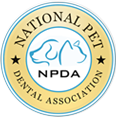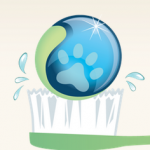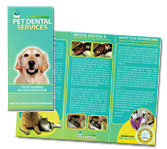“The services provided by Pet Dental Services have proven to be invaluable to our practice. Our clients appreciate the safety and convenience that non-anesthetic dentistry provides to their pets. Pet Dental Service’s staff is incredibly kind and patient with the pets in their care. Even some of our fearful patients are able to benefit from a full dental cleaning due to the gentle care provided by the PDS staff.”
POPD – Non-Anesthetic Dental Cleaning For Dogs and Cats
Veterinarians commonly recommend prophylactic, or preventive, anesthetic dental cleanings to their patients on an annual basis to combat the periodontitis (dental disease) that can lead to other major health issues in dogs and cats. But what can a veterinarian, or a pet owner, do to prevent dental disease in young animals before it occurs, as well as maintain a pet’s good oral health after dental x-rays and an anesthetic cleaning, and when the pet in question is not a good candidate for general anesthesia?
POPD is a new, non-anesthetic veterinary dental cleaning procedure that solves that dilemma using highly-qualified and trained certified dental technicians in your veterinarian’s own clinical setting.
What is POPD?
Professional Outpatient Preventive Dentistry (POPD) is a term developed by Pet Dental Services to describe their non-anesthetic teeth cleaning procedure performed on dogs and cats. Performed under the direct supervision of a veterinarian, POPD utilizes a type of gentle proprietary behavioral management to allow your pet to have a complete visual dental examination and preventive cleaning of all tooth surfaces without the use of a general anesthesia.
Pet Dental Services formed the National Pet Dental Association to increase pet owner awareness about the dangers associated with seeking medical procedures such as dental cleanings without veterinary supervision. The practice of on-site veterinary supervision is one of many policies that differentiate the POPD from the Non-Professional Dental Scaling (NPDS) typically executed by non-professionals in non-veterinary facilities, often using sub-standard and dangerous methods. Always make sure a veterinarian is present during your pet’s medical procedures!
The NPDA’s Board of Directors includes several highly-regarded human periodontists and dental veterinary technicians who oversee the extensive training of the certified dental technicians performing the POPD procedures. These technicians are mandated to treat their animal patients much as a human pediatric dental patient is treated – with patience and gentle kindness to avoid frightening and possibly injuring the patient.
How is a POPD procedure performed?
Your pet’s veterinarian must first recommend the non-anesthetic procedure for your dog or cat before one of Pet Dental Services skilled and highly-trained certified dental technicians will perform the cleaning. Typically, those animals with severe gingivitis, caries, fractured teeth or stomatitis are poor candidates for POPD.
The certified dental technician then evaluates your pet’s temperament to see if the patient’s behavior will allow for a successful procedure. If a pet is overly fearful or anxious and it is determined that the non-anesthetic treatment will not be a viable option, the hygienist will recommend an alternative treatment approach. By approaching patients calmly and patiently, and introducing each phase of the treatment slowly, the hygienist is able to build enough trust with your pet employing gentle behavior management so that the tools of traditional veterinary dentistry can be used to clean the teeth.
Under the on-site supervision of your veterinarian, the hygienist performs a thorough oral exam of your pet’s gums and mouth looking for loose teeth, abscesses and pockets of infection, fractured teeth, bone degeneration, tumors, and other conditions that necessitate your vet recommending an anesthetic dental procedure. If no such problems are found, your pet’s teeth are scraped above and below the gum line – meaning all plaque and tartar is gently removed and rinsed away. Scaling is accomplished using a piezoelectric scaler that uses ultrasonic sound waves to remove hard dental calculus without heating the surface of the tooth. The teeth will be machine-polished to remove the incidental micro etching where food particles and bacteria are most likely to adhere, and all tooth surfaces are rinsed of debris.
Your pet is fully conscious and awake during the entire procedure; your pet has complete control over its gag reflex so risk of aspiration is not a concern.
What type of pet does the procedure work best for?
POPD or Non-anesthetic dental cleanings are a great alternative for older pets, and for those pets with chronic liver, kidney, or heart disease that might not be good candidates for general anesthesia. The hygienist sits at eye level with your pet and uses a variety of proprietary holds to maintain control while keeping your dog or cat calm and comfortable; POPD may also works well for those animals that become anxious or upset during long visits at the vet clinic.
How can veterinarians and pet owners best use the POPD program?
POPD is not intended to replace traditional veterinary dentistry; rather, it serves as an additional therapy to anesthetic dental procedures.
When performed correctly, and prescribed appropriately by veterinarians, POPD can be used as maintenance therapy between anesthetic dentals for younger pets with a high predisposition for dental disease, or for high-risk patients unable to safely undergo anesthesia. Pet owner compliance – with at-home dental brushing – can help with prevention of further dental disease and that prevention increases with more frequent routine cleanings and oral examinations.

 Dr. Melissa Byers
Lake Forest Animal Clinic
Lake Forest, CA
Dr. Melissa Byers
Lake Forest Animal Clinic
Lake Forest, CA







